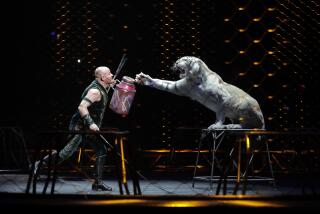A tradition they want to put out to pasture
- Share via
NEW YORK — Love and marriage, for Kelly Respess, are better suited to a horseless carriage -- specifically, the antique Ford that delivered her to her wedding on a busy Central Park corner.
It was a small but eye-catching salvo in the long-running war between animal rights activists such as Respess and her groom, Paul Kercheval, and the horse-drawn carriages that are as much a fixture in Central Park as rats are in subway tunnels.
If the Kerchevals have their way, a fleet of electric cars made to resemble vintage automobiles will replace the hansom cabs -- retaining, the couple says, Central Park’s old-world flavor while relieving the beasts of their burden and being kind to the environment. The newlyweds belong to People for the Ethical Treatment of Animals, which recently began pushing the antique car idea in New York.
“Think ‘Great Gatsby,’ ” said Virginia Fort of PETA as she made the final preparations for the wedding ceremony. A white strip of cloth sprinkled with rose petals served as the aisle, which led to an altar. To the side, a small table was laden with bottles of sparkling cider and a cake topped with two tiny figurines showing a happy couple -- of horses.
The setting was less than romantic: buses belched, taxis honked and passing sirens blared. The scent of horse urine was heavy in the summer air.
Respess, 25, and Kercheval, 26, chose the site because it was in full view of the horse-drawn buggies that line up along Central Park South, awaiting riders who pay $34 for about half an hour of clop-clopping through the urban wilderness.
Animal rights groups have made little headway in their campaign to end the practice, despite support from some politicians and celebrities.
Chrissie Hynde of the Pretenders was the star attraction at a protest in New York last year. The singer, who got married in one of the horse-drawn buggies in the 1980s, said: “The marriage didn’t last, and I hope the carriages meet the same fate.”
An elderly woman in a wheelchair watching the Kercheval nuptials could relate. Long ago, she said, she went on a date with a man who took her on a carriage ride. She didn’t much like the man, and the buggy jaunt did not endear her to the industry. Still, the woman -- who wanted to be identified only by her initials, J.D. -- said she suspected that as long as the carriages provided jobs, they were here to stay.
“It gets to me when it’s really hot and those poor horses are having to pull people around,” said J.D., who watches the buggies from her apartment. “But I can see where people visiting New York would see it as an attractive thing to do.”
City councilman and mayoral candidate Tony Avella began pushing for a ban in 2007 after Smoothie, a 13-year-old carriage horse, was spooked by a passing musician’s drum. Smoothie bolted, crashed into a tree and died.
A public hearing in January drew hundreds of people, but the proposed ban went nowhere. Mayor Michael R. Bloomberg has argued that it would put hundreds of carriage drivers out of work at an especially difficult economic time.
The pro-carriage lobby also has its celebrities -- including actor Liam Neeson, who weighed in during the January hearing with a letter to city officials that read in part: “The horse-drawn carriage business is an iconic part of this city, employing hundreds of dedicated, hard-working men and women, caring for well-bred, well-trained horses and attracting tourists to New York City for over 100 years.”
The drivers, who joined the Teamsters union this year in order to strengthen their position, agree. “Politicians should be creating jobs, not destroying them,” said Giovanni, a 15-year driver from Italy who would not give his full name for fear of getting into trouble with his boss.
Giovanni also dismissed activists’ allegations that the horses were mistreated. When it is too hot, too cold or too humid, he said, inspectors with the American Society for the Prevention of Cruelty to Animals show up and order the horses to be taken off duty.
PETA advocates phasing in electric replicas of antique cars and giving the horse-drawn carriage operators the new drivers’ medallions, so that no one would lose a job.
The search is on for a company to provide the vehicles, said Respess and Kercheval, who are no strangers to animal activism.
Earlier this year, they lay naked in Times Square slathered in fake blood to protest the running of the bulls in Pamplona, Spain. Respess once painted herself blue to appear as a giant M&M; and stood in the snow to demand that animals not be used in candy company testing.
For the vegans, the wedding-as-protest was a no-brainer. “We chose to get hitched. Those horses don’t have that choice,” said Respess, who wore a fluffy, snow-white gown and carried a bouquet of red roses and white lilies.
Her mother, Gail O’Neill, said she had no qualms about seeing her daughter get married on a traffic-choked corner. Strangers burst into applause as the groom kissed the bride.
Asked if she thought the public ceremony would make a difference in the carriage fight, O’Neill replied, “It might only be one-thousandth of a percent, but it’ll be one step forward. You don’t turn around, you don’t look back, you just keep putting the word out.”
Viktoria Schrager seemed torn as her 3-year-old son, Sam, watched Giovanni’s chocolate brown horse, Diamond, devour food from a bucket. In a city like New York, where the skyscrapers are visible even from the depths of Central Park, the horses are a welcome respite, Schrager said.
“It’s the only piece of nature that’s out and about in the city. I feel badly for the horses because they don’t look very happy, but there has to be a happy medium,” she said as Giovanni helped Sam feed Diamond a carrot.
“These kinds of moments, they’re special,” Schrager said.
Not to the newlyweds, who say it would be more special if people could enjoy New York from the back seat of a gleaming 1936 Ford -- or at least a reproduction. “Things change,” Respess said, dismissing the notion that a piece of New York would be lost if the carriages were banned.
With that, she and Kercheval climbed into the beige Ford, which was decorated with a sign reading, “Just Hitched and Not to a Carriage,” and drove away.
--
More to Read
Sign up for Essential California
The most important California stories and recommendations in your inbox every morning.
You may occasionally receive promotional content from the Los Angeles Times.














